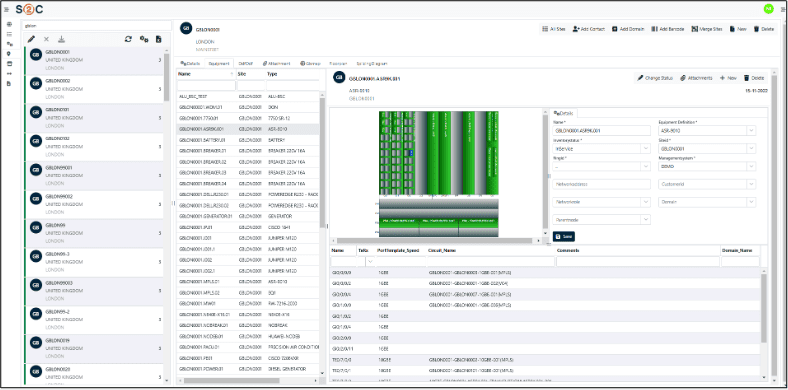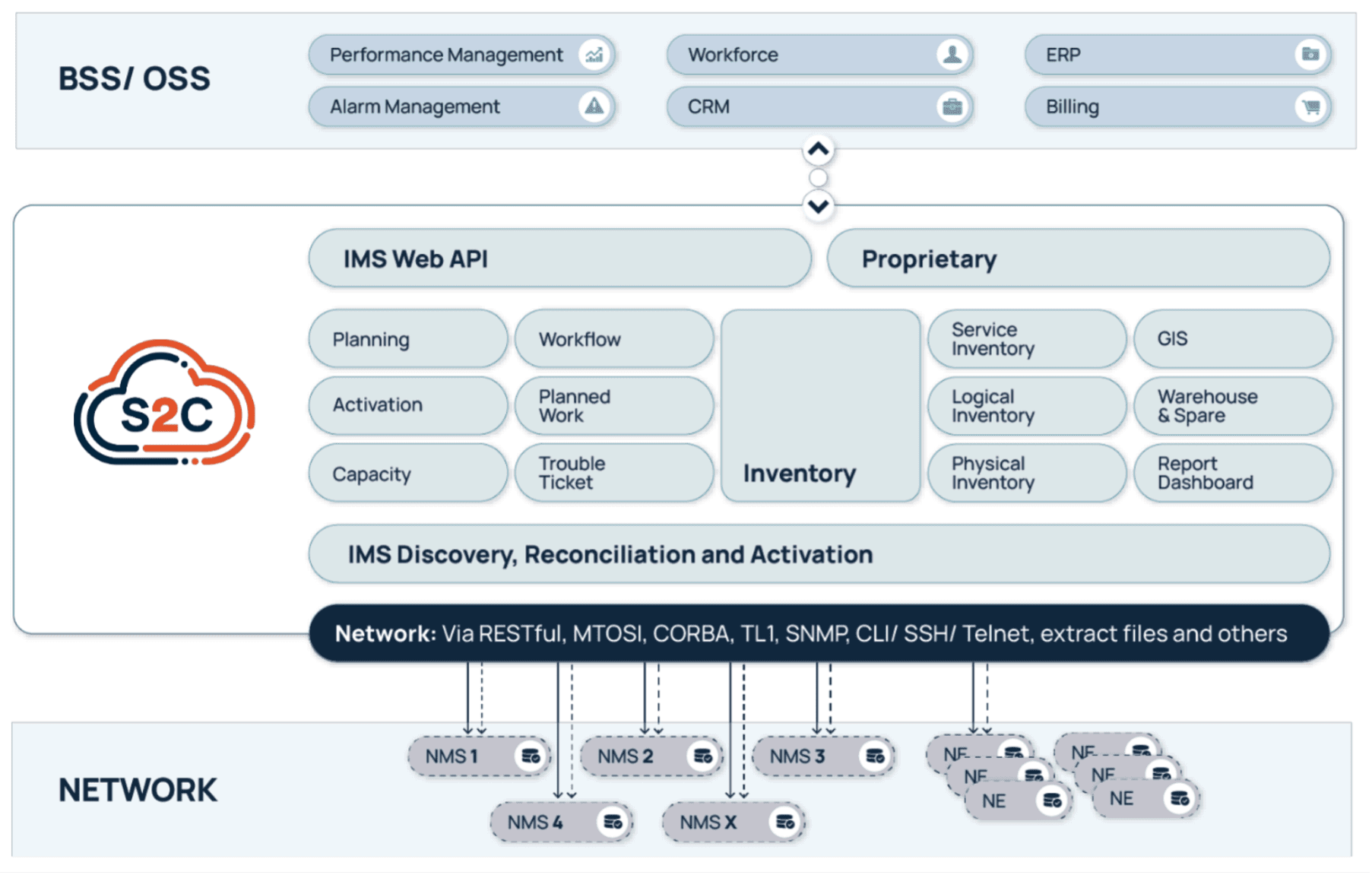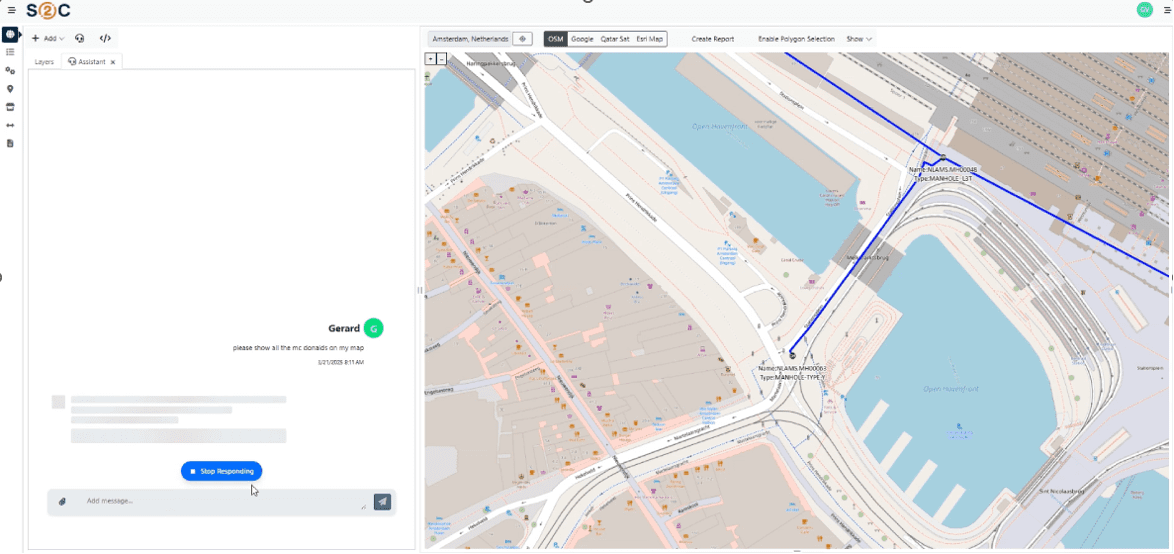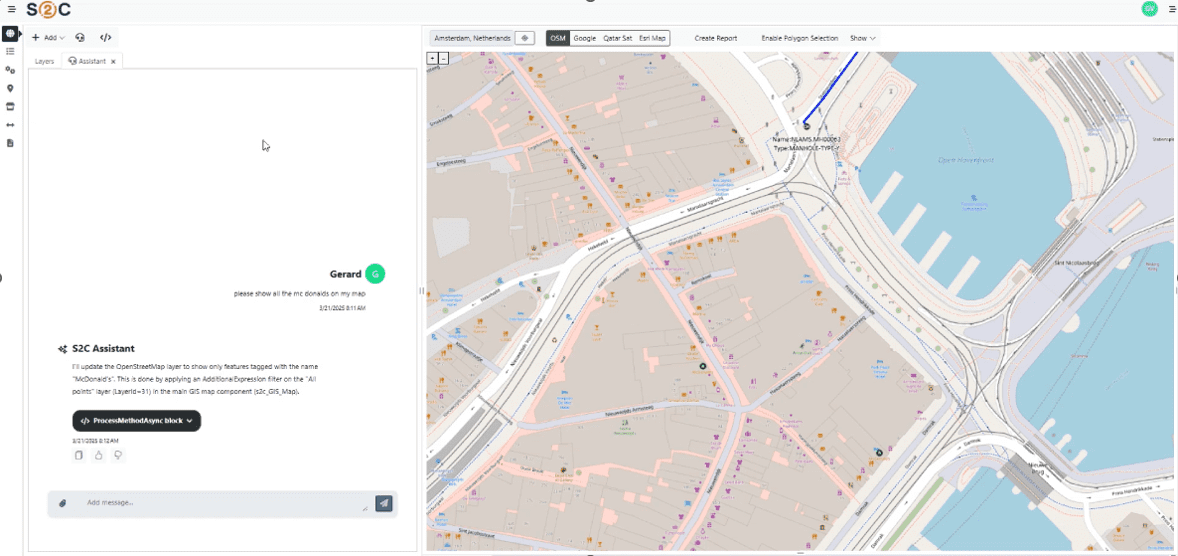Uncategorized
Smart electromagnetic surfaces/RIS: an optimal low-cost design for integrated communications, sensing and powering
Researchers at Xidian University in China have pioneered a smart electromagnetic surface that converts ambient electromagnetic waves into electrical power, marking a potential leap in stealth and wireless technologies. This meta-surface innovation merges advanced electromagnetic engineering with communication principles, enabling self-powered systems for demanding applications. The self-sustaining electronic system integrates wireless information transfer and energy harvesting and has the potential to upend the dynamics of electronic warfare.
The surface facilitates simultaneous energy harvesting and data transmission, drawing power from radar or environmental signals without traditional batteries. Xidian’s team highlights its role in “electromagnetic cooperative stealth,” where networked platforms collaboratively minimize radar cross-sections and sensor detectability. Prototypes demonstrate viability for real-time wave manipulation, building on metasurface designs that dynamically adjust phase and amplitude.
The researchers said this included investigating “electromagnetic cooperative stealth,” where multiple entities work together to reduce their visibility to radar and electromagnetic sensors. In electronic warfare, the technology flips the script on radar threats: stealth aircraft could harvest enemy beams for propulsion or comms, reducing logistical vulnerabilities. This cooperative approach extends to multi-asset formations, enhancing collective invisibility across spectra.
Early tests align with broader Reconfigurable Intelligent Surfaces (RIS), a two-dimensional reflecting surface. RIS advancements facilitate beam steering up to ±45° with low side lobes. According to a paper published in the IEEE Internet of Things magazine last year, RIS could also be used in anti-jamming technology, unmanned aerial vehicle communication and radio surveillance – all of which are difficult to do using older optimization tools.
Reconfigurable intelligent surfaces can also be configured to create intentional radio “dead zones” to mitigate interference and reduce the risk of eavesdropping, according to German electronics manufacturer Rohde & Schwarz. The European Space Agency has further highlighted RIS as a candidate technology for satellite-to-ground communications, where controllable reflection and redirection of signals could help route links around physical obstacles.

For telecommunications, the surface promises 6G breakthroughs like integrated sensing and powering satellites or base stations. China’s lead here could accelerate reconfigurable networks, improving coverage in non-line-of-sight scenarios. Ongoing refinements target complex interactions for higher precision. By including sensing, communication and power into one hardware platform, the device could allow for a range of advanced applications while reducing eavesdropping and interference.
“Ultimately, it is expected to have a broad impact on 6G communications, the Internet of Things, intelligent stealth and other related fields,” the team said in a paper published in the peer-reviewed journal National Science Review last month. Many scientists say that a key area for next-generation wireless communications will be the transmission channel.
Researchers from Fudan University, the University of Sydney and the Commonwealth Scientific and Industrial Research Organization note that, when combined with artificial intelligence (AI), this technology could significantly enhance the security of air-to-ground Internet of Things (IoT) links.
In their latest publication, the Xidian University team describes RIS as a “powerful solution” for future wireless networks, citing its low cost, high programmability and ease of deployment. However, for 6G systems, RIS must support both communication and sensing on a unified hardware platform by integrating data transmission and radar-like functionality to lower cost and optimize spectrum and hardware resource utilization.
Addressing this requirement will demand architectures that can jointly manipulate both scattered electromagnetic waves and actively radiated signals. The researchers propose that an electromagnetic all-in-one radiation–scattering RIS architecture could provide a viable path to meeting this dual-control challenge. “This achieves significant savings in physical space and cost while ensuring multifunctionality across diverse application scenarios,” the team said. The RIS system could also work in a receiver mode to harvest wireless energy to be used to power the meta-surface itself or charge other electronic devices, the paper added.
It could be used for line-of-sight wireless communication, where there is a direct, unobstructed path between a transmitter and receiver, as well as non-line-of-sight wireless communication, in which there is no direct visual link due to physical barriers like buildings.
The proposed RIS “stands out as the optimal low-cost design” for integrated communication and sensing. “In the future, this architecture could enable the development of environment-adaptive integrated sensing and communication systems, micro base stations and relay integrated systems, as well as self-powered sensing systems,” the team said.
………………………………………………………………………………………………………………………………………………………………………………………
References:
https://ieeexplore.ieee.org/document/10907868
Nokia sees new types of 6G connected devices facilitated by a “3 layer technology stack”
Electromagnetic Signal & Information Theory (ESIT): From Fundamentals to Standardization-Part I.
Electromagnetic Signal and Information Theory (ESIT): From Fundamentals to Standardization-Part II.
IMT Vision – Framework and overall objectives of the future development of IMT for 2030 and beyond
ITU-R WP5D: Studies on technical feasibility of IMT in bands above 100 GHz
Summary of ITU-R Workshop on “IMT for 2030 and beyond” (aka “6G”)
Excerpts of ITU-R preliminary draft new Report: FUTURE TECHNOLOGY TRENDS OF TERRESTRIAL IMT SYSTEMS TOWARDS 2030 AND BEYOND
Juniper Research: Global 6G Connections to be 290M in 1st 2 years of service, but network interference problem looms large
Groq and Nvidia in non-exclusive AI Inference technology licensing agreement; top Groq execs joining Nvidia
AI chip startup Groq [1.] today announced that it has entered into a non-exclusive licensing agreement with Nvidia for Groq’s AI inference technology [2.]. The agreement reflects a shared focus on expanding access to high-performance, low cost inference. As part of this agreement, Jonathan Ross, Groq’s Founder, Sunny Madra, Groq’s President, and other members of the Groq team will join Nvidia to help advance and scale the licensed technology. Groq will continue to operate as an independent company with Simon Edwards stepping into the role of Chief Executive Officer. GroqCloud will continue to operate without interruption. It remains to be seen how Groq’s new collaboration with Nvidia will effect its recent partnership with IBM.
Note 1. Founded in 2016, Groq specializes in what is known as inference, where artificial intelligence (AI) models that have already been trained respond to requests from users. While Nvidia dominates the market for training AI models (see Note 2.), it faces much more competition in inference, where traditional rivals such as Advanced Micro Devices have aimed to challenge it as well as startups such as Groq and Cerebras Systems.
Note 2. Training AI models (used by Nvidia GPUs) involves teaching a model to learn patterns from large amounts of data, while AI “inferencing” refers to using that trained model to generate outputs. Both processes demand massive computing power from AI chips.
…………………………………………………………………………………………………………………………………………………………………………………………………….
Groq has achieved a significant financial milestone, elevating its post-money valuation to $6.9 billion from $2.8 billion following a successful $750 million funding round in September. The company distinguishes itself in the competitive AI chip landscape by employing a unique architectural approach that does not rely on external high-bandwidth memory (HBM) chips. This design choice, leveraging on-chip static random-access memory (SRAM), mitigates the supply chain constraints currently impacting the global HBM market.
The LPU (Language Processing Unit) architecture, while enhancing inference speed for applications like chatbots, currently presents limitations regarding the maximum size of AI models that can be efficiently served. Groq’s primary competitor utilizing a similar architectural philosophy is Cerebras Systems, which has reportedly commenced preparations for an initial public offering (IPO) as early as next year. Both companies have strategically secured substantial contracts in the Middle Eastern market.
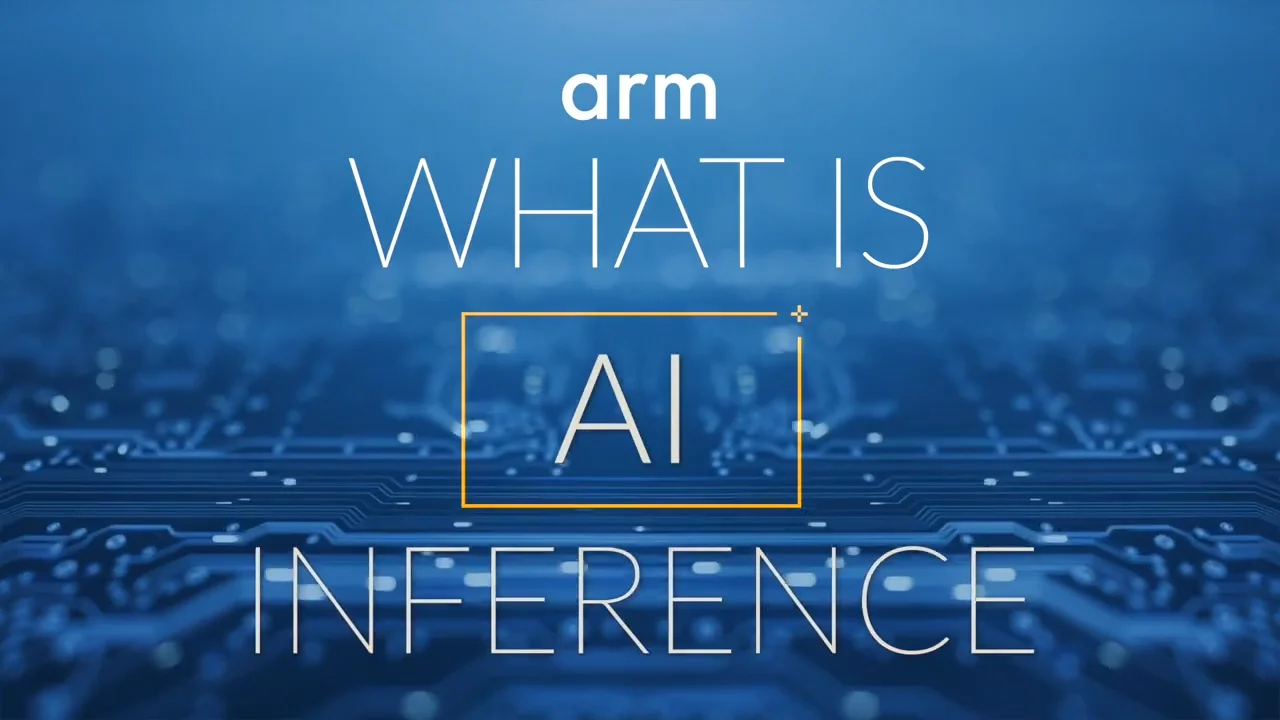
Nvidia’s investments in AI firms span the entire AI ecosystem, ranging from large language model developers such as OpenAI and xAI to “neoclouds” like Lambda and CoreWeave, which specialize in AI services and compete with its Big Tech customers. Nvidia has also invested in chipmakers Intel and Enfabrica. The company made a failed attempt around 2020 to acquire British chip architecture designer Arm Ltd. Nvidia’s wide-ranging investments — many of them in its own customers — have led to accusations that it’s involved in circular financing schemes reminiscent of the dot-com bubble. The company has vehemently denied those claims.
…………………………………………………………………………………………………………………………………………………………………..
This deal follows a familiar pattern in recent years where the world’s biggest technology firms pay large sums in deals with promising startups to take their technology and talent but stop short of formally acquiring the target.
- A great example of that was Meta which in June invested ~$14.3 billion in Scale AI for a 49% stake in the company. That move valued the startup at around $29 billion. As part of that deal, 28 year old Alexandr Wang resigned as CEO of Scale AI to become Meta’s first-ever Chief AI Officer. He will remain on Scale AI’s board of directors. Wang’s team at the new “superintelligence” lab is tasked with building advanced AI systems that can surpass human-level intelligence.
- In a similar but smaller scale deal, Microsoft agreed to pay AI startup Inflection about $650 million in cash in an unusual arrangement that would allow Microsoft to use Inflection’s models and hire most of the startup’s staff including its co-founders, a person familiar with the matter told Reuters. The high-profile AI startup’s models will be available on Microsoft’s Azure cloud service, the source said. Inflection is using the licensing fee to pay Greylock, Dragoneer and some other investors, the source added, saying the investors will get a return of 1.5 times what they invested.
Bernstein analyst Stacy Rasgon wrote in a note to clients on Wednesday after Groq’s announcement:
“The Nvidia-Groq deal appears strategic in nature for Nvidia as they leverage their increasingly powerful balance sheet to maintain dominance in key areas…..Antitrust would seem to be the primary risk here, though structuring the deal as a non-exclusive license may keep the fiction of competition alive (even as Groq’s leadership and, we would presume, technical talent move over to Nvidia). Nvidia CEO Jensen Huang’s “relationship with the Trump administration appears among the strongest of the key U.S. tech companies.”
…………………………………………………………………………………………………………………………………………………………………………………………………………….
Nvidia CEO Jensen Huang recently dedicated a significant portion of his 2025 GTC 2025 conference keynote speech to emphasize that Nvidia intends to maintain its market dominance as the AI sector increasingly transitions its focus from model training to inference workloads. Huang delivered two major GTC keynotes in 2025: The primary annual conference held in San Jose, California, in March 2025 and a second GTC in Washington, D.C., in October 2025. At these events, he emphasized the rise of “reasoning AI” and “agentic AI” as the drivers for an unprecedented 100x surge in demand for inference computing in just a couple of years. Huang announced that the new Blackwell system, designed as a “thinking machine” for reasoning, was in full production and optimized for both training and large-scale inference workloads.
Huang shared a vision of moving from traditional data centers to “AI factories“—ultra-high-performance computing environments designed specifically to generate intelligence at scale, positioning investment in Nvidia’s infrastructure as an economic necessity.
…………………………………………………………………………………………………………………………………………………………………………………………………………….
References:
https://www.arm.com/glossary/ai-inference
IBM and Groq Partner to Accelerate Enterprise AI Inference Capabilities
Sovereign AI infrastructure for telecom companies: implementation and challenges
AI wireless and fiber optic network technologies; IMT 2030 “native AI” concept
Custom AI Chips: Powering the next wave of Intelligent Computing
OpenAI and Broadcom in $10B deal to make custom AI chips
Reuters & Bloomberg: OpenAI to design “inference AI” chip with Broadcom and TSMC
Analysis: OpenAI and Deutsche Telekom launch multi-year AI collaboration
Expose: AI is more than a bubble; it’s a data center debt bomb
Will the wave of AI generated user-to/from-network traffic increase spectacularly as Cisco and Nokia predict?
Ookla: FWA Speed Test Results for big 3 U.S. Carriers & Wireless Connectivity Performance at Busy Airports
Ookla just released two new reports based on Speedtest Intelligence data, revealing critical shifts in how Americans connect to the Internet- from their homes and from the country’s 50 busiest airports.
Key findings from the first report:
- T-Mobile, AT&T and Verizon — adding 1.04 million new subscribers in Q3 2025 bringing the total number of FWA customers to 14.7 million, which is slightly more than 12.5% of the 117.4 million U.S. households with broadband, according to the U.S. Census Bureau’s 2024 American Community Survey.
- T-Mobile, Verizon and AT&T all experienced declines in both their median download and upload speeds during Q2 2025 and Q3 2025.
- T-Mobile is the FWA speed leader with median download speed of 209.06 Mbps for Q3 2025, which is approximately double that of AT&T’s median download speed of 104.63 Mbps in the same quarter.
- AT&T and T-Mobile customers in the 10th percentile of users are experiencing speed declines during peak hours in the late afternoon and evening. Verizon subscribers in the 10th percentile don’t have the same sorts of declines, indicating the operator’s enforcement of speed caps may be helping it deliver a more consistent experience to those customers.
- AT&T Internet Air’s latency is higher than its peers but it’s improving. AT&T’s median multi-server latency is ~ 67 milliseconds, “consistently higher” than Verizon (54 ms) and T-Mobile (50 ms) but a notable improvement from 78 ms in Q3 2024.
Separately, the analysts at New Street Research estimated AT&T, T-Mobile and Verizon can currently support up to 32 million FWA customers and they have already added nearly 50% of that number. Operators could potentially increase that load to 36 million following the Federal Communications Commission’s (FCC) upper C-Band auction.
…………………………………………………………………………………………………………………………………………………………………………………
Ookla’s second report analyzes cellular and Wi-Fi performance across the top 50 U.S. airports by passengers. Key findings:
- Cellular network providers had a faster median download speed than Wi-Fi in most airports and more than twice as fast on average. The overall median download speed for cellular was 219.24 Mbps. Note that 5G/4G splits were not explicitly examined.
- Verizon was fastest in the most airports comparing among all mobile providers and airport Wi-Fi including ties.
- Airport Wi-Fi was faster than mobile networks in just over one-third of head-to-head comparisons (including ties), and faster than all mobile providers in five airports.
- Older Wi-Fi technologies may be holding back internet speed in airports with 72.9% of Speedtest samples on Wi-Fi 5 and older generation versus 46.0% in the U.S. overall.

Wi-Fi was faster than any mobile provider in these five airports:
- Cincinnati/Northern Kentucky International
- San Francisco International
- Orlando International
- Hartsfield–Jackson Atlanta International
- Baltimore/Washington International (tie)
Wi-Fi is better by the Bay:
As shown in Wi-Fi’s fastest five airports, Oakland International and Norman Y. Mineta San José International made that list. Rounding out the Bay Area airportstrio, the Wi-Fi speed in San Francisco International comfortably topped the mobile providers.
| Airport | AT&T | T-Mobile | Verizon | Airport Wi-Fi |
| Oakland International | 229.70 | 28.58 | 103.90 | 194.23 |
| Norman Y. Mineta San José International | 103.83 | 211.40 | 251.06 | 176.59 |
| San Francisco International (SFO) | 67.07 | 92.91 | 100.56 | 169.51 |
SFO was the only airport in Ookla’s analysis with Speedtest samples using the 6 GHz band. This was on Wi-Fi 6E – too soon to expect Wi-Fi 7 in airports – with a median download speed of 364.74 Mbps (also remarkable were the median upload speed of 426.04 Mbps and an 8 ms multi-server latency).
References:
https://www.ookla.com/articles/u-s-fwa-report-december-2025
https://www.ookla.com/articles/cellular-faster-than-wi-fi-in-us-airports
Ookla: Global performance of Apple’s in-house designed C1 modem in iPhone 16e
Ookla: Uneven 5G deployment in Europe, 5G SA remains sluggish; Ofcom: 28% of UK connections on 5G with only 2% 5G SA
Ookla: Europe severely lagging in 5G SA deployments and performance
Highlights of Ookla’s 1st Half 2024 U.S. Connectivity Report
Ookla: T-Mobile and Verizon lead in U.S. 5G FWA
Ookla Q2-2023 Mobile Network Operator Speed Tests: T-Mobile is #1 in U.S. in all categories!
Highlights of ITU Global Connectivity Report 2025 and the Baku Action Plan
The ITU Global Connectivity Report 2025, released at the conclusion of the World Telecommunication Development Conference (WTDC-25) in Baku, Azerbaijan, delivers a comprehensive assessment of how global connectivity has evolved from a scarce asset in 1994 into a foundational layer of the digital economy and everyday life, with close to 6 billion users projected to be online by 2025. Its analytical framework is anchored in the policy objective of achieving universal and meaningful connectivity (UMC), structured across six interdependent dimensions: Quality, Availability, Affordability, Devices, Skills, and Security.
The report underscores the socio‑economic gains associated with large‑scale digital transformation, including enhanced productivity, innovation, and service delivery across sectors. At the same time, it emphasizes that progress is constrained by persistent digital divides along income, gender, age, and geographic lines, as well as by escalating exposure to online harms, misinformation, and non‑trivial environmental externalities from ICT infrastructure and usage.
It suggests the era of easy, organic network expansion is over. While 74% of the world is now online, the curve is flattening, and the remaining deficits are structural rather than merely about access.
With an estimated 2.2 billion people still offline, ITU Member States (194) agreed this week on the Baku Action Plan—a four-year roadmap to 2029 designed to close these persistent divides.
The report provides detailed analysis of structural barriers to universal and meaningful connectivity (UMC), notably high connectivity and device costs, gaps in digital skills, and constrained access to appropriate end‑user devices. It translates this analysis into evidence‑based policy guidance focused on regulatory coherence, targeted affordability interventions, and demand‑side enablers to ensure that connectivity translates into effective and inclusive digital usage.
From a network engineering and infrastructure perspective, the report highlights the critical role of resilient, high‑capacity backbones, including submarine cable systems and satellite constellations, as strategic layers of the global connectivity fabric. It stresses the need for coordinated investment, robust redundancy and security models, and integrated planning across terrestrial, subsea, and space‑based networks to support UMC objectives.
The report identifies high service and device costs, insufficient digital skills, and limited device availability as key barriers, and provides evidence‑based policy guidance on regulatory coherence, affordability, and demand‑side enablers. It emphasizes the importance of resilient infrastructure such as submarine cables and satellites, along with stronger national data ecosystems, to support inclusive connectivity strategies and informed digital policy‑making.
Finally, the report calls for strengthening national data ecosystems—covering data collection, governance, sharing, and analytics—as a prerequisite for effective digital inclusion strategies and evidence‑driven policy‑making. It positions mature data capabilities and coherent digital governance frameworks as key enablers for monitoring progress across the six UMC dimensions and for calibrating telecom and ICT policy in line with evolving market and technology dynamics.
References:
https://www.itu.int/itu-d/reports/statistics/global-connectivity-report-2025/
ITU’s Facts and Figures 2025 report: steady progress in Internet connectivity, but gaps in quality and affordability
ITU-R WP 5D reports on: IMT-2030 (“6G”) Minimum Technology Performance Requirements; Evaluation Criteria & Methodology
ITU-R report: Applications of IMT for specific societal, industrial and enterprise usages
https://www.itu.int/itu-d/reports/statistics/global-connectivity-report-2022/
VC4 Advances OSS Transformation with an Efficient and Reliable AI enabled Network Inventory System
By Juhi Rani assisted by IEEE Techblog editors Ajay Lotan Thakur and Sridhar Talari Rajagopal
Introduction:
This year, 2025, VC4 [a Netherlands Head Office (H/O) based Operational Support System (OSS) software provider] has brought sharp industry focus to a challenge that many experience in telecom. Many operators/carriers still struggle with broken, unreliable, and disconnected inventory systems. While many companies are demoing AI, intent-based orchestration, and autonomous networks, VC4’s newly branded offering, Service2Create (or S2C as it’s known to some), is refreshingly grounded. Also as we have learnt very quickly, bad data into AI is a “no-no”. None of the orchestration and autonomous networks, will work accurately if your OSS is built on flawed data. The age-old saying “Garbage in, Garbage out” comes to mind.
VC4’s platform, Service2Create (S2C), is a next-generation OSS inventory system that supports the evolving needs of telecom operators looking to embrace AI, automate workflows, and run leaner, smarter operations. Service2Create is built from over two decades of experience of inventory management solutions – IMS. By focusing on inventory accuracy and network transparency, S2C gives operators a foundation they can trust.
Inventory: The Most Underestimated Barrier to Transformation
In a post from TM Forum, we observed that operators across the world are making huge investments in digital transformation but many are slowed by a problem closer to the ground: the inability to know what exactly is deployed in the network, where it is, and how it’s interconnected.
VC4 calls this the “silent blocker” to OSS evolution.
Poor mis-aligned inventory undermines everything. It breaks service activations, triggers unnecessary truck rolls, causes billing mismatches, and frustrates assurance teams. Field engineers often discover real-world conditions that don’t match what’s in the system, while planners and support teams struggle to keep up. The problem doesn’t just stop with network data.
In many cases, customer records were also out of date or incomplete… and unknown inventory can also be a factor. Details like line types, distance from the central office, or whether loading coils were present often didn’t match reality. For years, this was one of the biggest issues for operators. Customer databases and network systems rarely aligned, and updates often took weeks or months. Engineers had to double-check every record before activating a service, which slowed delivery and increased errors. It was a widespread problem across the industry and one that many operators have been trying to fix ever since.
Over time, some operators tried to close this gap with data audits and manual reconciliation projects, but those fixes never lasted long. Networks change every day, and by the time a cleanup was finished, the data was already out of sync again.
Modern inventory systems take a different approach by keeping network and customer data connected in real time. They:
- Continuously sync with live network data so records stay accurate.
- Automatically validate what’s in the field against what’s stored in the system.
- Update both customer and network records when new services are provisioned.
In short, we’re talking about network auto-discovery and reconciliation, something that Service2Create does exceptionally well. This also applies for unknown records, duplicate records and records with naming inconsistencies/variances.
It is achieved through continuous network discovery that maps physical and logical assets, correlates them against live service models, and runs automated reconciliation to detect discrepancies such as unknown elements, duplicates, or naming mismatches. Operators can review and validate these findings, ensuring that the inventory always reflects the true, real-time network state. A more detailed explanation can be found in the VC4 Auto Discovery & Reconciliation guide which can be downloaded for free.
Service2Create: Unified, Reconciled, and AI-Ready
Service2Create is designed to reflect the actual, current state of the network across physical, logical, service and virtual layers. Whether operators are managing fiber rollout, mobile backhaul, IP/MPLS cores, or smart grids, S2C creates a common source of truth. It models infrastructure end-to-end, automates data reconciliation using discovery, and integrates with orchestration platforms and ticketing tools.
To make the difference clearer here is the table below shows how Service2Create compares with the older inventory systems still used by many operators. Traditional tools depend on manual updates and disconnected data sources, while Service2Create keeps everything synchronized and validated in real time.
Comparison between legacy inventory tools and Service2Create (S2C)
| Feature | Legacy OSS Tools | VC4 Service2Create (S2C) |
|---|---|---|
| Data reconciliation | Manual or periodic | Automated and continuous |
| Inventory accuracy | Often incomplete or outdated | Real-time and verified |
| Integration effort | Heavy customization needed | Standard API-based integration |
| Update cycle | It takes days or weeks | Completed in hours |
| AI readiness | Low, needs data cleanup | High, with consistent and normalized data |
What makes it AI-ready isn’t just compatibility with new tools, it’s data integrity. VC4 understands that AI and automation only perform well when they’re fed accurate, reliable, and real-time data. Without that, AI is flying blind.
Built-in Geographic Information System (GIS) capabilities help visualize the network in geographic context, while no/low-code workflows and APIs support rapid onboarding and customization. More than software, S2C behaves like a data discipline framework for telecom operations.
Service2Create gives operators a current, trusted view of their network, improving accuracy and reducing the time it takes to keep systems aligned.
AI is Reshaping OSS… But only if the Data is Right
AI is driving the next wave of OSS transformation from automated fault resolution and dynamic provisioning to predictive maintenance and AI-guided assurance. But it’s increasingly clear: AI doesn’t replace the need for accuracy; it demands it.
In 2025, one common thread across operators and developers was this: telcos want AI to reduce costs, shorten response times, and simplify networks. According to a GSMA analysis, many operators continue to struggle as their AI systems depend on fragmented and incomplete datasets, which reduces overall model accuracy.
VC4’s message is cutting through: AI is only as useful as the data that feeds it. Service2Create ensures the inventory is trustworthy, reconciled daily with the live network, and structured in a way AI tools can consume. It’s the difference between automating chaos and enabling meaningful, autonomous decisions.
Service2Create has been adopted with operators across Europe and Asia. In national fiber networks, it’s used to coordinate thousands of kilometers of rollout and maintenance. In mixed fixed-mobile environments, it synchronizes legacy copper, modern fiber, and 5G transport into one unified model.
Designed for Operational Reality
VC4 didn’t build Service2Create for greenfield labs or ideal conditions. The platform is designed for real-world operations: brownfield networks, legacy system integrations, and hybrid IT environments. Its microservices-based architecture and API-first design make it modular and scalable, while its no/low-code capabilities allow operators to adapt it without long customization cycles. See the diagram below.
S2C is deployable in the cloud or on-premises and integrates smoothly with Operational Support System / Business Support System (OSS/BSS) ecosystems including assurance, CRM, and orchestration. The result? Operators don’t have to rip and replace their stack – they can evolve it, anchored on a more reliable inventory core.
What Industry Analysts are Saying
In 2025, telco and IT industry experts are also emphasizing that AI’s failure to deliver consistent ROI in telecom is often due to unreliable base systems. One IDC analyst summed it up: “AI isn’t failing because the models are bad, it’s failing because operators still don’t know what’s in their own networks.”
A senior architect from a Tier 1 European CSP added, “We paused a closed-loop automation rollout because our service model was based on inventory we couldn’t trust. VC4 was the first vendor we saw this year that has addressed this directly and built a product around solving it.”
This year the takeaway is clear: clean inventory isn’t a nice-to-have. It’s step one.
Looking Ahead: AI-Driven Operations Powered by Trusted Inventory
VC4 is continuing to enhance Service2Create with capabilities that support AI-led operations. Currently, S2C is enhanced with AI-powered natural language interfaces through Model Context Protocol (MCP) servers. This creates a revolutionary way for users to access their data and makes it also easier for them to do so. Simply ask for what you need, in plain language, and receive instant, accurate results from your systems of record.
The S2C platform now offers multiple synchronized access methods:
- Natural Language Interface
- Ask questions in plain language: “Show me network capacity issues in Amsterdam”
- AI translates requests into precise system queries
- No training required – productive from day one
- Direct API Access via MCP
- Programmatic access using Language Integrated Query (LINQ) expressions
- Perfect for integrations and automated workflows
- Industry-standard authentication (IDP)
- S2C Visual Platform
- Full-featured GUI for power users
- Parameterized deeplinks for instant component access
- Low/no-code configuration capabilities
- Hybrid Workflows
-
- Start with AI chat, graduate to power tools
- AI generates deeplinks to relevant S2C dashboards
Export to Excel/CSV for offline analysis
-
What It All Comes Down To
Digital transformation sounds exciting on a conference stage, but in the trenches of telecom operations, it starts with simpler questions. Do you know what’s on your network? Can you trust the data? Can your systems work together?
That’s what Service2Create is built for. It helps operators take control of their infrastructure, giving them the confidence to automate when ready and the clarity to troubleshoot when needed.
VC4’s approach isn’t flashy. It’s focused. And that’s what makes it so effective – a direction supported by coverage from Subseacables.net, which reported on VC4’s partnership with AFR-IX, to automate and modernize network operations across the Mediterranean.
………………………………………………………………………………………………………………….
About the Author:
Juhi Rani is an SEO specialist at VC4 B.V. in the Netherlands. She has successfully directed and supervised teams, evaluated employee skills and knowledge, identified areas of improvement, and provided constructive feedback to increase productivity and maintain quality standards.
Juhi earned a B. Tech degree in Electronics and Communications Engineering from RTU in Jaipur, India in 2015.
……………………………………………………………………………………………………………………………………………………………………..
Ajay Lotan Thakur and Sridhar Talari Rajagopal are esteemed members of the IEEE Techblog Editorial Team. Read more about them here.
Nokia Bell Labs and KDDI Research partner for 6G energy efficiency and network resiliency
Nokia Bell Labs and KDDI Research have partnered to advance 6G technology, focusing on improving network energy efficiency and resilience. The collaboration combines KDDI’s real-world network data and operational insights with Nokia Bell Labs’ expertise in energy consumption models and programmable network architectures. This joint research agreement, signed on November 5, 2025, builds on a long history of cooperation and aims to accelerate the development and deployment of sustainable, intelligent 6G networks.
Under this new agreement, the two companies are conducting research in two key areas of 6G:
- mMIMO energy efficiency: New techniques for reducing base-station energy consumption while enhancing communication, specifically targeted at proposed 6G spectrum.
- Distributed programmable core network services for 6G: New mobile core technologies that will ensure continuous communication during infrastructure failures and natural disasters.
KDDI Research and Nokia Bell Labs will demonstrate their initial work in mMIMO energy efficiency at the Brooklyn 6G Summit Nov 5 – 7.
Peter Vetter, President, Core Research, Nokia Bell Labs:
“Tackling the inherent challenges in a new generation of networking requires close collaboration in the industry. Working side by side, KDDI Research and Nokia Bell Labs can advance the state of the art in networking thanks to different perspectives on the problems and possible solutions. Ultimately, the joint outcomes will make 6G a more resilient, efficient and intelligent technology.”
Satoshi Konishi, President and CEO, KDDI Research:
“Through our strategic and close collaboration with Nokia Bell Labs, we aim to accelerate R&D initiatives and further strengthen the ‘Power to Connect’ toward 6G. We strive to continuously deliver new value to our customers and make meaningful contributions to societal progress.”
References:
KDDI unveils AU Starlink direct-to-cell satellite service
KDDI Partners With SpaceX to Bring Satellite-to-Cellular Service to Japan
KDDI Deploys DriveNets Network Cloud: The 1st Disaggregated, Cloud-Native IP Infrastructure Deployed in Japan
AWS Integrated Private Wireless with Deutsche Telekom, KDDI, Orange, T-Mobile US, and Telefónica partners
Samsung and KDDI complete SLA network slicing field trial on 5G SA network in Japan
Nokia’s Bell Labs to use adapted 4G and 5G access technologies for Indian space missions
Nokia and Rohde & Schwarz collaborate on AI-powered 6G receiver years before IMT 2030 RIT submissions to ITU-R WP5D
Highlights of Nokia’s Smart Factory in Oulu, Finland for 5G and 6G innovation
Will the wave of AI generated user-to/from-network traffic increase spectacularly as Cisco and Nokia predict?
Nokia Bell Labs claims new world record of 800 Gbps for transoceanic optical transmission
Nokia Bell Labs sets world record in fiber optic bit rates
Market research firms Omdia and Dell’Oro: impact of 6G and AI investments on telcos
Market research firm Omdia (owned by Informa) this week forecast that 6G and AI investments are set to drive industry growth in the global communications market. As a result, global communications providers’ revenue is expected to reach $5.6 trillion by 2030, growing at a 6.2% CAGR from 2025. Investment momentum is also expected to shift toward mobile networks from 2028 onward, as tier 1 markets prepare for 6G deployments. Telecoms capex is forecast to reach $395 billion by 2030, with a 3.6% CAGR, while technology capex will surge to $545 billion, reflecting a 9.3% CAGR.
Fixed telecom capex will gradually decline due to market saturation. Meanwhile, AI infrastructure, cloud services, and digital sovereignty policies are driving telecom operators to expand data centers and invest in specialized hardware.
Key market trends:
- CP capex per person will increase from $74 in 2024 to $116 in 2030, with CP capex reaching 2.5% of global GDP investment.
-
Capital intensity in telecom will decline until 2027, then rise due to mobile network upgrades.
-
Regional leaders in revenue and capex include North America, Oceania & Eastern Asia, and Western Europe, with Central & Southern Asia showing the highest growth potential.
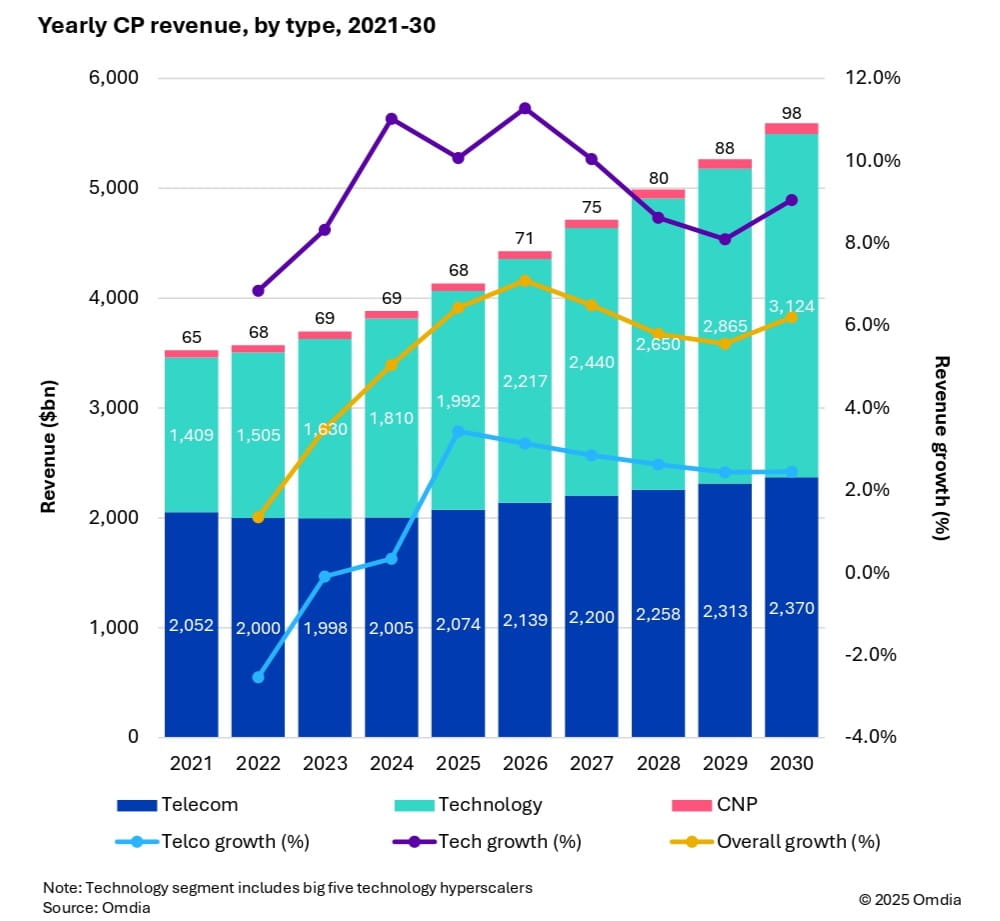 Dario Talmesio, research director at Omdia said, “telecom operators are entering a new phase of strategic investment. With 6G on the horizon and AI infrastructure demands accelerating, the connectivity business is shifting from volume-based pricing to value-driven connectivity.”
Dario Talmesio, research director at Omdia said, “telecom operators are entering a new phase of strategic investment. With 6G on the horizon and AI infrastructure demands accelerating, the connectivity business is shifting from volume-based pricing to value-driven connectivity.”
Omdia’s forecast is based on a comprehensive model incorporating historical data from 67 countries, local market dynamics, regulatory trends, and technology migration patterns.
…………………………………………………………………………………………………………………………………………………
Separately, Dell’Oro Group sees 6G capex ramping around 2030, although it warns that the RAN market remains flat, “raising key questions for the industry’s future.” Cumulative 6G RAN investments over the 2029-2034 period are projected to account for 55% to 60% of the total RAN capex over the same forecast period.
“Our long-term position and characterization of this market have not changed,” said Stefan Pongratz, Vice President of RAN and Telecom Capex research at Dell’Oro Group. “The RAN network plays a pivotal role in the broader telecom market. There are opportunities to expand the RAN beyond the traditional MBB (mobile broadband) use cases. At the same time, there are serious near-term risks tilted to the downside, particularly when considering the slowdown in data traffic,” continued Pongratz.
Additional highlights from Dell’Oro’s October 2025 6G Advanced Research Report:
- The baseline scenario is for the broader RAN market to stay flat over the next 10 years. This is built on the assumption that the mobile network will run into utilization challenges by the end of the decade, spurring a 6G capex ramp dominated by Massive MIMO systems in the Sub-7GHz/cm Wave spectrum, utilizing the existing macro grid as much as possible.
- The report also outlines more optimistic and pessimistic growth scenarios, depending largely on the mobile data traffic growth trajectory and the impact beyond MBB, including private wireless and FWA (fixed wireless access).
- Cumulative 6G RAN investments over the 2029-2034 period are projected to account for 55 to 60 percent of the total RAN capex over the same forecast period.
Dell’Oro Group’s 6G Advanced Research Report offers an overview of the RAN market by technology, with tables covering manufacturers’ revenue for total RAN over the next 10 years. 6G RAN is analyzed by spectrum (Sub-7 GHz, cmWave, mmWave), by Massive MIMO, and by region (North America, Europe, Middle East and Africa, China, Asia Pacific Excl. China, and CALA). To purchase this report, please contact by email at [email protected].
References:
https://www.lightreading.com/6g/6g-momentum-is-building
6G Capex Ramp to Start Around 2030, According to Dell’Oro Group
https://www.lightreading.com/6g/6g-course-correction-vendors-hear-mno-pleas
https://www.lightreading.com/6g/what-at-t-really-wants-from-6g
AT&T’s convergence strategy is working as per its 3Q 2025 earnings report
AT&T reported a 1.6% increase in third-quarter revenue to $30.7 billion, driven by its convergence strategy which combines wireless and fiber services. This strategy attracted profitable customers, as evidenced by 405,000 postpaid phone net additions and 550,000 new subscribers for AT&T’s advanced broadband services, including Fiber and Internet Air. The growth in these areas offset a decline in business wireline revenue.
“We have the key building blocks in place to give our customers the best connectivity experience in the industry and we’re winning the race to lead in convergence,” said John Stankey, AT&T Chairman and CEO.
“We continue to add highly-profitable customers that are choosing AT&T for all their connectivity needs on the country’s fastest and largest wireless and fiber networks. It’s clear our differentiated investment-led strategy is working, and we remain on track to achieve all of our 2025 consolidated financial guidance.”

Here are a few AT&T 3Q 2025 highlights:
- Postpaid Phone Subscribers: Gained 405,000 net additions.
- AT&T Fiber: Added 288,000 new subscribers.
- AT&T Internet Air: Added 270,000 new subscribers, marking a strong quarter for broadband net additions overall.
- Total Revenue increased 1.6% year-on-year to $30.7 billion.
- Mobility Revenue grew 3.1% year-over-year, supported by higher equipment sales and subscriber additions.
- Latin America Revenues were up 7.1% year on year to USD 1.10 billion amid subscriber and ARPU growth, higher equipment sales and the favourable effects of foreign exchange rates.
- Consumer Wireline Revenue increased 4.1%, led by an 8.2% rise in broadband revenue and strong fiber growth.
- Business Wireline Revenue declined 7.8%, mainly due to reductions in legacy services, though this was partially offset by growth in fiber and advanced connectivity services.
- The strategy is working because customers who bundle fiber and wireless services have lower churn and higher lifetime values, according to AT&T CEO John Stankey.
- More than 41% of AT&T Fiber households also have an AT&T Mobility service, which shows the success of this strategy.
- The company is on track to achieve its consolidated financial guidance for the year.
Stankey on AT&T’s competitive advantage (from Earnings Call transcript):
“We offer fast and reliable connectivity for 5G and fiber at attractive price points. More people are choosing AT&T for both wireless and home internet services. Today, more than 41% of AT&T Fiber households also choose AT&T for wireless. And the pace of this convergence trend within our customer base continues to grow. These customers remain our most valuable, with the lowest churn profile and highest lifetime values.
Our success with convergence also extends to fixed wireless. More than half of our Internet Air subscribers also choose AT&T for their wireless service. Similar to fiber, these customers exhibit lower churn and drive higher lifetime values than customers with stand-alone services.
The EchoStar spectrum we agreed to acquire will improve our 5G wireless performance in a cost-efficient manner, while allowing us to grow Internet Air at a faster pace. We’re already making great progress, delivering on our commitment to deploy this valuable spectrum for the benefit of American consumers and businesses.
We started deploying the 3.45 GHz spectrum that we have agreed to acquire from EchoStar under a short-term spectrum manager lease. Based on our current rate and pace, we expect these mid-band licenses will be deployed in cell sites covering nearly two-thirds of the US population by mid-November.
This should position us to further expand the availability of Internet Air 5G FWA) in our sales channels in 2026. Our ability to move this quickly reflects the great work of our teams and the FCC’s pro-investment and supportive policy environment. We’re also making great progress in preparing to close our transaction with Lumen. Most of the senior leadership team has been identified, and we now expect to close this transaction in the early part of 2026.
As I’ve said before, where we have fiber, we win with both fiber and 5G, and we plan to win even more as our investments in these assets bring advanced connectivity to more Americans. The supportive (FCC) policy environment is also making it easier for us to transition away from outdated legacy infrastructure and invest in the AI-ready connectivity that Americans want and need.
The bottom line is that we now have the right building blocks in place to realize our scaled fiber and fixed wireless ambitions, complete our wireless modernization, and successfully transition away from legacy infrastructure. As we complete our key investments, acquisitions, and transformation initiatives, we expect to increase our fiber and convergence penetration rates and see a majority of incremental revenue growth originate from converged customer relationships.”
Outlook & Financial Guidance:
AT&T reiterated its guidance for the 2025 financial year, with service revenue growth in the low single-digit range and mobility service revenue growth of 3 percent or better. It still foresees consumer fibre broadband revenue growth in the mid-to-high teens. Annual adjusted EBITDA growth should be 3 percent or better. Mobility EBITDA growth will be about 3 percent. Business wireline EBITDA will decline at a low double-digit rate and EBITDA growth for consumer wireline is still forecast in the low to mid-teen range. FY capital investment will be in the USD 22 billion to USD 22.5 billion range. AT&T predicts free cash flow in the low-to-mid USD 16 billion range. It continues to forecast FY adjusted EPS of USD 1.97 to USD 2.07.
AT&T reiterated its long-term financial guidance of service revenue growth in the low-single-digit range annually from 2026-2027, adjusted EBITDA growth of 3 percent or better annually, and adjusted EPS accelerating to double-digit percentage growth in 2027. AT&T foresees capital investment in the range USD 23 billion to USD 24 billion annually from 2026-2027. It predicts free cash flow of USD 18 billion or more in 2026 and USD 19 billion or more in 2027.
References:
https://about.att.com/story/2025/3q-earnings.html
https://www.telecompaper.com/news/att-says-convergence-boosts-q3-revenue-and-profitability–1551778
AT&T deploys nationwide 5G SA while Verizon lags and T-Mobile leads
AT&T to buy spectrum licenses from EchoStar for $23 billion
AT&T grows fiber revenue 19%, 261K net fiber adds and 29.5M locations passed by its fiber optic network
Analysts weigh in: AT&T in talks to buy Lumen’s consumer fiber unit – Bloomberg
T-Mobile’s new CEO Srini Gopalan faces fierce competition from AT&T, Verizon and MVNOs
AT&T sets 1.6 Tbps long distance speed record on its white box based fiber optic network
AT&T and Verizon cut jobs another 6% last year; AI investments continue to increase
Can the debt fueling the new wave of AI infrastructure buildouts ever be repaid?
IEEE Techblog has called attention to the many challenges and risks inherent in the current mega-spending boom for AI infrastructure (building data centers, obtaining power/electricity, cooling, maintenance, fiber optic networking, etc) . In particular, these two recent blog posts:
AI Data Center Boom Carries Huge Default and Demand Risks and
This article focuses on the tremendous debt that Open AI, Oracle and newer AI cloud companies will have to obtain and the huge hurdles they face to pay back the money being spent to build out their AI infrastructures. While the major hyperscalers (Amazon, Microsoft, Google and Meta) are in good financial shape and won’t need to take on much debt, a new wave of heavily leveraged firms is emerging—one that could reshape the current AI boom.
OpenAI, for example, is set to take borrowing and large-scale contracts to an unbelievable new level. OpenAI is planning a vast network of data centers expected to cost at least $1 trillion over the coming years. As part of this effort, the company signed a $300 billion, five-year contract this month under which Oracle “is to set up AI computing infrastructure and lease it to OpenAI.” In other words, OpenAI agreed to pay Oracle $300 billion over five years for the latter company to build out new AI data centers. Where will OpenAI get that money? It will be be burning billions in cash and won’t be profitable till 2029 at the earliest.
To fulfill its side of the deal, Oracle will need to invest heavily in infrastructure before receiving full payment—requiring significant borrowing. According to a recent note from KeyBanc Capital Markets, Oracle may need to borrow $25 billion annually over the next four years. This comes at a time when Oracle is already carrying substantial debt and is highly leveraged. As of the end of August, the company had around $82 billion in long-term debt, with a debt-to-equity ratio of roughly 450%. By comparison, Alphabet—the parent company of Google—reported a ratio of 11.5%, while Microsoft’s stood at about 33%.
Companies like Oracle and other less-capitalized AI players such as CoreWeave have little choice but to take on more debt if they want to compete at the highest level. Nebius Group, another Nasdaq-listed AI cloud provider similar to CoreWeave, struck a $19.4 billion deal in September to provide AI computing services to Microsoft. The company announced it would finance the necessary capital expenditures “through a combination of its cash flow and debt secured against the contract.”
………………………………………………………………………………………………………………………………………………………………………………………………
Sidebar – Stock market investors seem to love debt and risk:
CoreWeave’s shares have more than tripled since its IPO in March, while Nebius stock jumped nearly 50% after announcing its deal with Microsoft. Not to be outdone, Oracle’s stock surged 40% in a single day after the company disclosed a major boost in projected revenue from OpenAI in its infrastructure deal—even though the initiative will require years of heavy spending by Oracle.
–>What’s so amazing to this author is that OpenAI selected Oracle for the AI infrastructure it will use, even though the latter is NOT a major cloud service provider and is certainly not a hyperscaler. For Q1 2025, it held about 3% market share, placing it #5 among global cloud service providers.
…………………………………………………………………………………………………………………………………………………………………………………………………
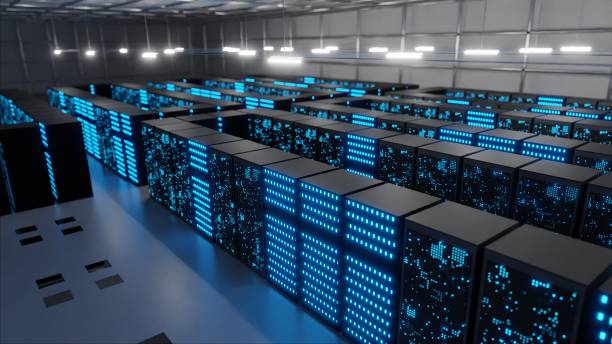
Data Center Compute Server & Storage Room; iStock Photo credit: Andrey Semenov
……………………………………………………………………………………………………………………………………………….
Among other new AI Cloud players:
- CyrusOne secured nearly $12 billion in financing (much in debt) for AI / data center expansion. Around $7.9 billion of that is for new data center / AI digital infrastructure projects in the U.S.
- SoftBank / “Stargate” initiative: The Stargate project (OpenAI + Oracle + SoftBank + MGX, etc.) is being structured with major debt. The plan is huge—around $500 billion in AI infrastructure and supercomputers, and financing is expected to be ~70% debt, ~10% equity among the sources.
- xAI (Elon Musk’s AI firm): xAI raised $10 billion in combined debt + equity. Specifically ~$5 billion in secured notes / term loans (debt), with the remainder in equity. The money is intended to build out its AI infrastructure (e.g. GPU facilities / data centers).
There’s growing skepticism about whether these companies can meet their massive contract obligations and repay their debts. Multiple recent studies suggest AI adoption isn’t advancing as quickly as supporters claim. One study found that only 3% of consumers are paying for AI services. Forecasts projecting trillions of dollars in annual spending on AI data centers within a few years appear overly optimistic.
OpenAI’s position, despite the hype, seems very shaky. D.A. Davidson analyst Gil Luria estimates the company would need to generate over $300 billion in annual revenue by 2030 to justify the spending implied in its Oracle deal—a steep climb from its current run rate of about $12 billion. OpenAI has financial backing from SoftBank and Nvidia, with Nvidia pledging up to $100 billion, but even that may not be enough. “A vast majority of Oracle’s data center capacity is now promised to one customer, OpenAI, who itself does not have the capital to afford its many obligations,” Luria said.
Oracle could try to limit risk by pacing its spending with revenue received from OpenAI. Nonetheless, Moody’s flagged “significant” risks in a recent note, citing the huge costs of equipment, land, and electricity. “Whether these will be financed through traditional debt, leases or highly engineered financing vehicles, the overall growth in balance sheet obligations will also be extremely large,” Moody’s warned. In July (two months before the OpenAI deal), it gave Oracle a negative credit outlook.
There’s a real possibility that things go smoothly. Oracle may handle its contracts and debt well, as it has in the past. CoreWeave, Nebius, and others might even pioneer new financial models that help accelerate AI development.
It’s very likely that some of today’s massive AI infrastructure deals will be delayed, renegotiated, or reassigned if AI demand doesn’t grow as fast as AI spending. Legal experts say contracts could be transferred. For example, if OpenAI can’t make the promised, Oracle might lease the infrastructure to a more financially stable company, assuming the terms allow it.
Such a shift wouldn’t necessarily doom Oracle or its debt-heavy peers. But it would be a major test for an emerging financial model for AI—one that’s starting to look increasingly speculative. Yes, even bubbly!
………………………………………………………………………………………………………………………………………………………………………………
References:
https://www.wsj.com/tech/ai/debt-is-fueling-the-next-wave-of-the-ai-boom-278d0e04
Verizon’s 6G Innovation Forum joins a crowded list of 6G efforts that may conflict with 3GPP and ITU-R IMT-2030 work
Verizon has established a 6G Innovation Forum with a group of companies to drive innovation and enabling the 6G era. Verizon’s future-forward initiative is uniting key players across the technology ecosystem, including leading network vendors Ericsson, Samsung Electronics, and Nokia; and device and chipset innovators Meta, and Qualcomm Technologies, Inc., in the early stages of development to define 6G together by identifying potential new use cases, devices and network technology. The forum aims to establish an open, diversified, and resilient 6G ecosystem and develop foundational 6G technologies while ensuring global alignment.
This effort underscores Verizon’s commitment to drive the collaborative evolution of connectivity and deliver transformative experiences for consumers and enterprises. Verizon’s networks form the backbone of the emerging Artificial Intelligence economy, delivering the infrastructure and expertise essential for businesses to fully harness AI’s potential. For over a decade, Verizon has integrated AI into its operations to optimize network performance and infrastructure, a commitment that will continue with the evolution of 6G. This will accelerate Verizon’s AI Connect strategy and intelligent edge capabilities, enabling businesses to manage real-time AI workloads at scale by leveraging Verizon’s comprehensive suite of solutions with its award-winning network.
The forum will move beyond theoretical discussions and rapidly progress toward tangible 6G advancements and the realization of potential new and innovative use cases. Key areas of focus will include:
- Unlocking the full potential of 6G by testing new spectrum bands and bandwidths.
- Fostering a globally harmonized 6G landscape by actively working with global standards bodies like 3GPP to ensure that the forum’s work aligns with mainstream 6G development and promotes interoperability across the industry.
- Allowing forum partners to test and refine 6G technologies in a real-world environment by establishing dedicated Verizon 6G Labs, starting in Los Angeles, to serve as hubs for collaborative research, prototyping, and early lab and field trials.
“Verizon is consistently at the forefront of network innovation. We were the first in the world to turn up 5G and continue to enhance our best, most reliable and fastest 5G network in ways that open the door to possibilities far beyond what we can imagine today,” said Joe Russo, EVP & President, Global Networks and Technology at Verizon. “5G Advanced lays the foundation for the 6G future – whether that’s new wearables, AI experiences, or entirely new use cases we haven’t even thought of yet, and that’s what excites me the most. With the best team in the industry, we will build the future of these solutions with our partners. We’re already building a network designed for the next era – one that will transform how we live, work and play.”
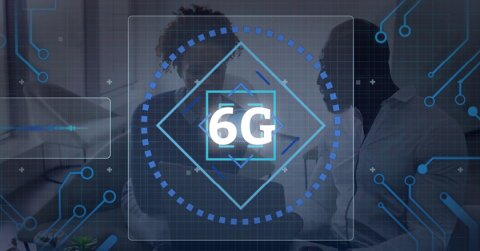
Yago Tenorio, the chief technology officer of Verizon told Light Reading he wants the Forum to identify and refine 6G use cases before technology details are agreed upon by 3GPP and ITU-R WP5D. Smart glasses combined with artificial intelligence (AI) have arguably emerged as the prime candidate to succeed smartphones as a mass-market 6G consumer gadget. Last week, displayed the sort of smart glasses that could become popular in a future 6G scenario.
“One example of why this forum matters is that if you go to the standards today there is a lot of talk about uplink capacity with eight antennas in the device,” Tenorio said . “I don’t have any problem with that. It’s going to be very useful for FWA [fixed wireless access] and maybe useful for some smartphones, some classes of devices. But can you imagine a wearable with eight antennas? I mean, it’s difficult enough to have two,” he added.
Comment and Analysis:
It seems there are way too many 6G Forums and Consortiums that overlap and potentially can generate conflicting specifications. The two main bodies are ITU-R and 3GPP.
- ITU-R WP5D sets the formal requirements for terrestrial international mobile telecommunications (IMT) and is working on the framework for IMT-2030 (the official designation for 6G). This framework, outlined in the ITU-R’s IMT-2030 vision and Recommendation ITU-R M. 2160, includes key aspects like technology trends, usage scenarios, and performance capabilities for the next generation of mobile networks. 5D also develops the minimum technical performance requirements (TPRs) for IMT-2030 (“6G”) which will be specified in a Report ITU-R M. [IMT-2030.TECH PERF REQ]. In February 2025, WP5D discussed a draft document on these requirements, and the next step is to detail the specific values for key metrics like peak data rate and spectral efficiency, with candidates for the radio interfaces to be submitted by early 2029 and finalized around mid-2030.
- 3GPP creates cellular specifications which are submitted to ITU-R WP5D by ATIS as contributions directed towards Radio Interface Technologies (RITs) and Sets of Radio Interface Technologies (SRITs). 3GPP began its 6G study work in 2024. It is working toward a first-phase 6G specification to be completed in Release 21 by late 2028, which will be submitted for consideration as the IMT 2030 RIT/SRIT standard. Note that ONLY 3GPP defines the 5G and 6G core network specifications. There is no serious work in ITU-T for the non-radio aspects of 5G or 6G.
Summary of 6G Forums:
- Next G Alliance: An initiative within the Alliance for Telecommunications Industry Solutions (ATIS) to advance North American leadership in wireless technology. It includes working groups focused on creating a 6G roadmap, defining applications and use cases, and addressing spectrum issues.
- AI-RAN Alliance: This group brings together technology and telecom leaders to integrate artificial intelligence (AI) directly into radio access network (RAN) technology to improve network performance, efficiency, and resource utilization in the lead-up to 6G.
- Verizon 6G Innovation Forum: Established in September 2025, this consortium unites companies such as Ericsson, Nokia, Samsung, Meta, and Qualcomm to develop the 6G ecosystem, identify use cases, and define foundational technologies.
- Brooklyn 6G Summit (B6GS): An annual flagship event hosted by Nokia and NYU, bringing together vendors, academia, and operators to discuss 6G research and innovation.
- 6G Smart Networks and Services Industry Association (6G-IA): A European-based group that represents the private sector and collaborates with the European Commission on 6G research initiatives. It oversees projects like Hexa-X and Hexa-X-II, which have helped define the 6G vision.
- 6G Flagship (Finland): Based at the University of Oulu, this is one of the world’s first 6G research programs. It leads multiple national and international projects, working to develop the components, tools, and test network for a 6G-enabled digital world.
- one6G: This non-profit association works to accelerate the adoption of next-generation wireless technologies by supporting global 6G research and standardization.
- China IMT-2030 (6G) Promotion Group, established in 2019 by the Ministry of Industry and Information Technology (MIIT) to coordinate government, academia, and industry efforts in promoting 6G research, development, and international cooperation. The group focuses on defining technical standards, exploring new applications like integrated sensing and non-terrestrial networks, and aims for 6G commercialization around 2030.
- 6G Forum (Korea): An organization working to lead and promote the evolution of wireless technology beyond 5G and into 6G, encouraging collaboration between industries, government, and academia.
- Bharat 6G Alliance (India): A partnership between Indian companies, academia, and research organizations to accelerate the country’s innovation and collaboration in 6G.
- XG Mobile Promotion Forum (Japan): This group, which has a memorandum of understanding with the Next G Alliance, focuses on advancing the 5G and 6G ecosystem.
- IEEE Future Networks: This IEEE initiative includes a Testbed Working Group that collaborates with existing 5G testbeds to accelerate the development of next-generation networks, including 6G.
- Research initiatives: Numerous specific projects and academic consortia worldwide are also driving focused research on various aspects of 6G, such as integrating AI into networks or developing specific components.
- See References below for more collaborative efforts directed at 6G.
……………………………………………………………………………………………………………………………………………………………………………..
References:
https://www.verizon.com/about/news/verizon-leads-future-wireless-development-new-industry-6g-forum
https://www.lightreading.com/6g/verizon-cto-worries-whether-6g-will-measure-up-in-the-us
Verizon launches 6G forum; it’s all about the use cases, CTO says
https://www.ericsson.com/en/6g/spectrum




